| |
Click on the maps for larger image |
| |
|
| Regional Surface Meteorological Networks |
| |
|
| Union Pacific Railroad Weather Station Network - The Union Pacific Railroad
operates this network of 264 weather stations (10 in Illinois) located in the central and western United
States. Further information on Union Pacific is available on their
home page. This network is included as part of the University of Utah
MesoWest and NOAA/Earth
System Research Laboratory (ESRL) Global Systems Division (GSD)
MADIS data sets. |
 . . |
| Great Lakes Environmental Research Laboratory
(GLERL) Real-Time Meteorological Observation Network - The GLERL operates
this network of 7 stations with locations primarily around southern Lake Michigan
(1 in Illinois).
The network provides up to 5-minute observations of air temperature, wind speed,
and wind direction. For further information visit the
GLERL network
home page. |
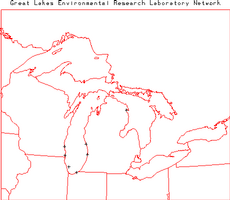 |
| |
|
| WMAQ WeatherNet
- WMAQ-TV in Chicago, Illinois operates this network of 113 stations located
primarily at schools throughout northern Illinois (108 in Illinois). The
network provides up to 1-minute observations of air temperature, relative
humidity, wind speed, wind direction, precipitation, and barometric pressure.
For further information visit the
WMAQ
network page. |
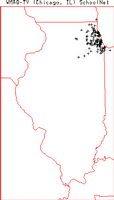 |
| |
|
| WSNS WeatherNet
- WSNS-TV in Chicago, Illinois operates this network of 187 stations located
primarily at schools throughout northern Illinois (177 in Illinois). The
network provides up to 1-minute observations of air temperature, relative
humidity, wind speed, wind direction, precipitation, and barometric pressure.
For further information visit the
WSNS
network page. |
No map yet. |
| |
|
| WSIL WeatherNet
- WSIL-TV in Carterville, Illinois operates this network of 14 stations located
primarily at schools throughout southern Illinois (12 in Illinois). The
network provides up to 1-minute observations of air temperature, relative
humidity, wind speed, wind direction, precipitation, and barometric pressure.
For further information visit the
WSIL
network page. |
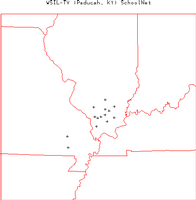 |
| |
|
| KPLR WeatherNet
- KPLR-TV in St. Louis, Missouri operates this network of 15 stations located
primarily at schools throughout eastcentral Missouri and southwestern Illinois
(7 in Illinois). The
network provides up to 1-minute observations of air temperature, relative
humidity, wind speed, wind direction, precipitation, and barometric pressure.
For further information visit the
KPLR
network page. |
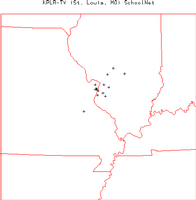 |
| |
|
| WTWO WeatherNet
- WTWO-TV in Terra Haute, Indiana operates this network of 14 stations located
primarily at schools throughout westcentral Indiana (1 in Illinois). The
network provides up to 1-minute observations of air temperature, relative
humidity, wind speed, wind direction, precipitation, and barometric pressure.
For further information visit the
WTWO
network page. |
 |
| |
|
| WFIE WeatherNet
- WFIE-TV in Evansville, Indiana operates this network of 14 stations located
primarily at schools throughout southwestern Indiana and western Kentucky
(1 in Illinois). The
network provides up to 1-minute observations of air temperature, relative
humidity, wind speed, wind direction, precipitation, and barometric pressure.
For further information visit the
WFIE
network page. |
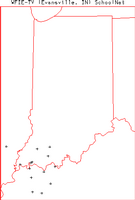 |
| |
|
| State and Local Surface Meteorological Networks |
| |
|
| Illinois Climate Network (ICN) - The Illinois State
Water Survey operates this network of 19 stations at locations throughout the state of
Illinois. The network provides hourly observations of air temperature, relative humidity,
wind speed, wind direction, solar radiation, evaporation, precipitation, and soil
temperature. For further information visit the
ICN home page. |
 |
| |
|
| Illinois Roadway Weather Information System (RWIS)
Network - The Illinois Department of Transportation operates this network of
49 stations located throughout the state of Illinois. The network provides observations
of air temperature, relative humidity, wind speed, wind direction, wind gust, and
precipitation at an unknown temporal resolution. For further information visit the
Illinois DOT RWIS
home page. |
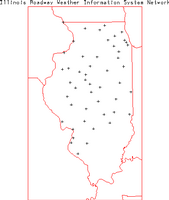 |
| |
|
| Illinois Air Monitoring Network - The Illinois
Environmental Protection Agency Bureau of Air operates this network of 27 stations located
throughout the state of Illinois. The majority of the stations (18) provide only hourly
observations of wind speed and wind direction. Another 5 of the stations provide solar
radiation in addition to the winds. Four of the stations (all located in northeastern
Illinois) provide a full set of meteorological parameters. For further information visit
the Bureau of Air home page. |
 |
| |
|
| Bondville Environmental and Atmospheric Research Site (BEARS) - This
site is operated by the Illinois State Water Survey at Bondville, Illinois. A number
of different data collection efforts take place at the site. These include and Illinois
Climate Network station, National Atmospheric Deposition Program, SURFRAD, UV-B Monitoring,
visibility monitoring, Atmospheric Integrated Monitoring Network, among others. For further
information visit the
BEARS home page. |
No map. |
| |
|
| WAND WeatherNet
- WAND-TV in Champaign, Illinois operates this network of 16 stations located
primarily at schools throughout eastcentral Illinois. The
network provides up to 1-minute observations of air temperature, relative
humidity, wind speed, wind direction, precipitation, and barometric pressure.
For further information visit the
WAND
network page. |
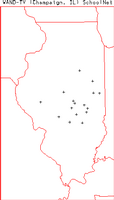 |
| |
|
| Precipitation and Radar Networks |
| |
|
| NOAA/National Centers for Environmental
Prediction (NCEP) Hourly Precipitation Data - NOAA/NCEP routinely develops
a National Multi-sensor Hourly Precipitation Analysis (Stage II) data set from
hourly radar precipitation estimates and from hourly gage reports. The gage data
includes hourly observations from ~4000 gages across the US (157 in Illinois)
collected by the NOAA River Forecast Centers and sent to NCEP. Further information
on these data is available at:
http://wwwt.emc.ncep.noaa.gov/mmb/ylin/pcpanl/. |
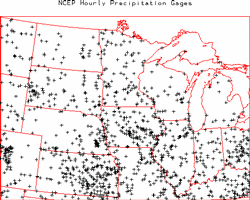 |
| |
|
| NOAA/NWS Cooperative Observer 15-minute Precipitation Network - The NOAA/NWS
routinely collects 15-minute observations of precipitation from Fisher-Porter and Universal
rain gages operated by 2777 cooperative observers located throughout the US (75 in Illinois).
These data are archived at NOAA/NCDC as data set TD 3260. For further information visit the
NOAA/NCDC TD3260 page at:
http://ols.nndc.noaa.gov/plolstore/plsql/olstore.prodspecific?prodnum=C00505-TAP-A0001 |
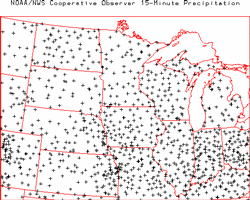 |
| |
|
| Cook County Precipitation Network - The
Illinois State Water Survey operates this network of 25 weighing bucket raingages
with locations throughout Cook County in northeastern Illinois. For further
information visit the
Cook
County Precipitation Network home page. |
Map at web site. |
| |
|
| Boneyard Precipitation Network - The Boneyard
Network currently consits of 18 volunterr observers in and around Champaign - Urbana,
mostly current and former Water Survey staff members. The network provides daily
observations of precipitation. For further information visit the
Boneyard
Precipitation Network home page. |
Map at web site. |
| |
|
| Weather Surveillance Radar 1988 Doppler (WSR-88D)
Network - The NOAA/NWS and the Department of Defense operate this network
of 143 WSR-88D radars across the contiguous US (2 in Illinois). The Level II
data are the three meteorological base data quantities (reflectivity, mean radial
velocity, and spectrum width) and are recorded at all NWS and most DOD sites.
Level II data are then processed in order to create a number of meteorological analysis
products known as Level III data. Level III data are recorded at the NWS sites. The
Level III products included base reflectivity, base spectrum width, base velocity,
composite reflectivity, echo tops, velocity azimuth display (VAD) wind profile,
vertically integrated liquid (VIL), 1-hour precipitation, storm total precipitation,
hail index overlay, mesocyclone overlay, severe weather probability overlay, storm
structure, storm tracking information overlay, and tornadic vortex signature overlay.
All Level II and III data are archived at NOAA/NCDC. For further information visit
the NOAA/NCDC Radar Resources page at:
http://www.ncdc.noaa.gov/oa/radar/radarresources.html or the NOAA Radar
Operations Center at:
http://www.roc.noaa.gov/. |
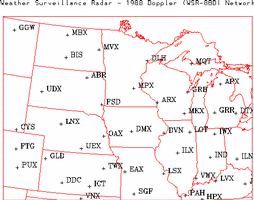 |
| |
|
| Radiation and Flux Networks |
| |
|
| Surface Radiation (SURFRAD) Budget Network - The SURFRAD network
is operated by the NOAA/Air Resources Laboratory (ARL)/Surface Radiation Research
Branch (SRRB). The primary parameters measured by each station include upwelling
and downwelling solar and infrared radiation. Ancillary observations include
direct and diffuse solar radiation, photosynthetically active radiation, UVB,
spectral solar, air temperature, relative humidity, wind speed, wind direction, and
barometric pressure. The temporal resolution of all observations is 3 minutes.
There are 6 SURFRAD sites currently located across the US (1 in Illinois), with 2
additional sites planned (Sioux Falls, SD and Canaan Valley, WV). For further
information visit the SURFRAD home page at:
http://www.srrb.noaa.gov/surfrad/. |
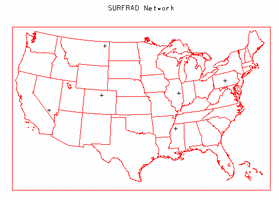 |
| |
|
| Baseline Surface Radiation Network (BSRN) -
The BSRN is a project of the World Climate Research Programme. The primary parameters
measured by each station include global radiation, direct and diffuse radiation,
downward longwave radiation, and meteorological observations. The networks includes 12
stations within the United States (1 in Illinois). For further information visit the
BSRN home page. |
 |
| |
|
| Environmental Protection Agency (EPA) Ultraviolet
Monitoring Program (UV-Net) - The EPA operates this network of 20 Brewer
spectrophotometers throughout the US (1 in Illinois). The network provides observations of
full-sky spectrally resolved solar radiation in the UV-B and UV-A bands. The
irradiance and total column ozone concentrations are derived from these data.
For further information visit the
EPA UV-Net page. |
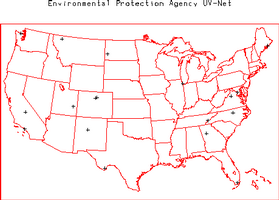 |
| |
|
| United States Department of Agriculture (USDA)
UV-B Monitoring Network - The USDA operates this network of 29 stations
with locations throughout the US (1 in Illinois). The network provides
3-minute observations of spectral total/direct/diffuse radiation, air temperature,
relative humidity, solar radiation, barometric pressure, and photosynthetically
active radiation. For further information visit the
USDA UV-B Monitoring page. |
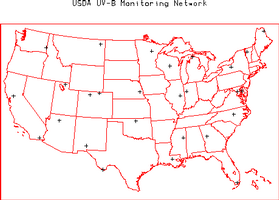 |
| |
|
| Ameriflux Network - The Ameriflux network consists of 54 sites conducting
long-term measurements of CO2, water and energy fluxes throughout the US (1 in Illinois).
The typical observational frequency is 30 minutes. The parameters measured at each site
vary, but Ameriflux has defined a core set of parameters that most sites collect, including
fluxes of CO2, energy and water, basic meteorological and radiation parameters, and soil
temperature and moisture. For further information visit the
Ameriflux home page or the
NOAA Air Resources Laboratory
Atmospheric Turbulence and Diffusion Division Surface Exchange Sites web page. |
 |
| |
|
| Soil Networks |
| |
|
| Soil Climate Analysis Network (SCAN) - The SCAN is operated by the United
States Department of Agriculture (USDA) Natural Resources Conservation Service (NRCS). The
network provides hourly observations of air temperature, relative humidity, wind speed,
wind direction, solar radiation, precipitation, barometric pressure, snow water content,
snow depth, soil temperature (at 2, 4, 8, 20, and 40 cm depths), and soil moisture (at 2, 4,
8, 20 and 40 cm depths). The 80 SCAN stations are located across the US in primarily
agricultural regions (1 in Illinois). For further information visit the
SCAN home page. |
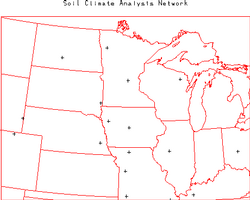 |
| |
|
| Illinois Soil Moisture Network - The Illinois
State Water Survey operates this network of 19 locations throughout the state of
Illinois. The network provides observations of soil moisture for the top 10 cm
and them for 20 cm layers (e.g. 10-30 cm, 30-50 cm ...) down to a depth of 2 m.
For further information visit the
Global Soil Moisture Data Bank. |
 |
| |
|
| North Central River Forecast Center (NCRFC) Soil Temperature Network -
The NCRFC operates this network of 47 stations (5 in Illinois) that collect weekly
readings of soil temperature at depths of 2, 4, 8, 20, 40 and 60 in at locations throughout
the north central US. For further information visit the
NCRFC Soil
Temperature Network web page. |
 |
| |
|
| Hydrology Networks |
| |
|
| United States Geological Survey (USGS) Streamflow
Network - The USGS (part of the US Department of the Interior) operates this
network of 7237 streamflow gages (196 in Illinois) at locations throughout the US.
The network provides hourly or more frequent observations of stage (water level) from
which discharge (flow) is computed using a stage-discharge rating relation. The
rating is defined by occasional direct current-meter measurements of discharge. All
data are available through the USGS and the district offices in each state. Many of
these gages provide realtime data
relayed via the GOES satellite data collection system. The realtime data are
provisional data that have not been reviewed or edited. These realtime data
may be subject to significant change and are not citeable until reviewed and approved
by the USGS. Realtime data may be changed after review because the stage-discharge
relationship may have been affected by: 1) backwater from ice or debris; 2) algal and
aquatic growth in the stream; 3) sediment movement; and 4) malfunction of recording
equipment. Each station record is considered provisional until the data are
published. The data are usually published with 6 months of the end of the water year
(1 October to 30 September). Data users are cautioned to consider carefully the
provisional nature of the information before using it. For further information on the
USGS streamflow network visit the
USGS Water Resources of the United States page or the
USGS Illinois District Office
home page. |
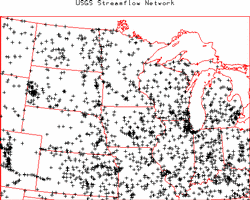 |
| |
|
| Upper Air Networks |
| |
|
| NOAA/NWS Radiosonde Network Low Vertical Resolution Data - The NOAA/NWS
typically releases radiosondes twice per day at 0000 and 1200 UTC at 69 locations throughout
the US (1 in Illinois). During special weather situations the NWS can request to release
additional radiosondes at off-times (e.g. 1800 UTC). The low resolution data is sent out
over the Global Telecommunications System (GTS) and provides mandatory and significant level
observations of pressure, altitude, temperature, dew point, wind speed, and wind direction.
There are 3 types of radiosondes utilized within the US network, Vaisala, VIZ (or Sippican),
and Microsonde. These data are archived by NOAA/NCDC and other organizations. For further
information on the NWS Radiosonde network visit the
NWS Upper-air Observations Program
home page. A several year archive of GTS upper air data is available at the
NOAA/FSL Radiosonde Database. |
 |
| |
|
| NOAA/NWS Radiosonde Network High Vertical Resolution Data - The same
radiosonde locations mentioned in the previous data set also provide a 6-second vertical
resolution data set that provides observations of pressure, temperature, altitude,
relative humidity, and azimuth and elevation angles. UCAR/JOSS has developed software
to derive 6-second vertical resolution winds from the angle data. These data are
archived by NCDC and UCAR/JOSS. |
 |
| |
|
| NOAA Profiler Network (NPN) - The
NOAA/Forecast Systems Laboratory (FSL) operates this network of 32 404 MHz wind
profilers primarily across the central portion of the United States (1 in Illinois).
Each site provides 6-minute and hourly vertical profiles of wind speed and wind
direction. Additionally, 11 of the NPN sites have a collocated Radio Acoustic
Sounding System (RASS) that provides 6-minute and hourly vertical profiles of
virtual temperature (none in Illinois). For further information visit the
NPN home page.
An archive of the hourly wind profiles is available from
NCAR/SCD. |
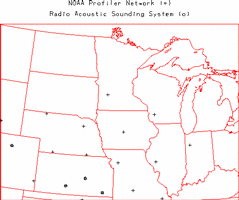 |
| |
|
| Ground Based Global Positioning System (GPS) Meteorology Demonstration Network
(GPS-MET) - The NOAA/FSL ingests data from 323 GPS locations around the US
operated by many different agencies (4 in Illinois). Typically each location provides
30-minute observations of integrated precipitatable water along with a number of surface
meteorology parameters (air temperature, relative humidity, barometric pressure, etc).
For further information visit the
GPS-MET home page. |
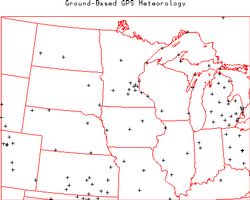 |
| |
|
| Other Networks |
| |
|
| Aerosol Robotic Network (AERONET) - AERONET is an optical ground-based aerosol
monitoring network and data archive supported by NASA's Earth Observing System. The network
hardware consists of identical automatic sun-sky scanning spectral radiometers owned by national
agencies and universities. Data from this collaboration provides globally distributed (1 in Illinois)
near real time observations of aerosol spectral optical depths, aerosol size distributions and precipitable
water. For further information visit the
AERONET home page. |
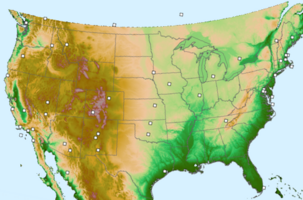 |
 .
.


























 .
.

























